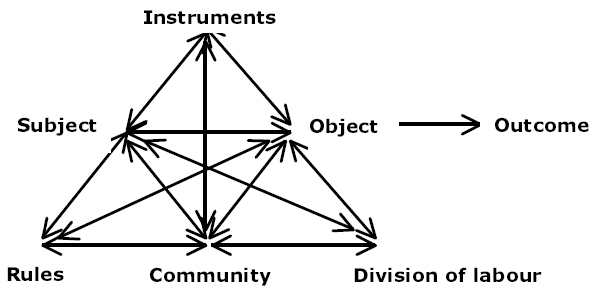Activity theory and information seeking / Wilson (2008)
Citation - Wilson, T. D. (2008). Activity theory and information seeking. Annual review of information science and technology, 42(1), 119-161.
Keyword - Activity theory
Content
- Introduction: AT 能夠作為一種整合分散LIS研究的理論範式(IR, information seeking behavior, institutional-library-research)
- The Origins of Activity Theory: 介紹AT歷史淵源。Lev Vygotsky, Sergei Leonidovich Rubinshtein, Leont’ev.
- The Nature of Activity Theory: AT的本質。
- sociocultural psychology
- Kaptelinin & Nardi ([1996]) AT六項一般原則
- 在其他領域的發展應用
- 在LIS可能的發展與應用
主要概念與模型
Leont'ev 描繪的 Vygotsky AT。Vygotsky 並沒有提到“Mediating artifact”, 而是“psychological tools”, 即: 語言、書寫、數學、地圖等符號結構。

Engeström (1987) 將 Leont'ev 的AT 以新的圖示描繪,加上了社群、規則、分工。

原則
意識與活動的統一 / the unity of consciousness and activity
- 來自 Vygotsky學派關於意識(consciousness)的研究
- 主張: 意識,或「心智(mind)」,源於人類與外在世界的活動中。
The key notion is that consciousness, or “mind” in a more generic sense, emerges in evolution through human activity in relation to the external world. - Kaptelinin (1996:107)1)
> 活動理論最基礎的原則,是意識與活動的統一。在此處,「意識」指人類心智,「活動」指人類與客觀現實的互動。此原則主張人類心智是人類與環境互動的一個重要部件。心智是一種幫助有機體存活,在演化過程中出現的特殊「器官」。因此,心智只能在活動的脈絡中,被分析與理解。
> The most fundamental principle of activity theory is that of the unity of consciousness and activity. “Consciousness” in this expression means the human mind as a whole, and “activity” means human interaction with the objective reality. This principle, therefore, states that the human mind emerges and exists as a special component of human interaction with the environment. Mind is a special “organ” that appears in the process of evolution to help organisms to survive. Thus, it can be analyzed and understood only within the context of activity.
客體(對象)導向的: object orientation
- 人類/主體的活動作用的對象/客體。此對象可以是實際的物質實體,或是社會文化上的實體。
> The principle of object orientation is simply that human activity is directed toward objects that have a scientifically determinable “reality” and/or a socioculturally determined reality. Thus, we have “real world” objects such as the raw material of, say, the woodcarver, whose activity is to act upon the block of wood to transform it into a carving, and we have the socially constructed objects of, for example, the peer group, which individual members may seek to transform by introducing new potential members.
內部化/外部化: internalization/externalization
- 由於前兩點原則,我們的心智歷程必然是我們外在活動內化的結果。
- 我們對周遭世界的意識是因我們對世界的活動而形成的,另一方面,我們透過活動固定我們對世界的內在概念。
- 根據 Vygotsky ,語言是我們內化外部經驗的方法。
調解中介: mediation (Wilson 沒有講什麼,主要在介紹工具是什麼)
- activity is mediated by tools.
活動的階層結構: the hierarchical structure of activity
- Leont’ev 區分 activity, actions, operations; 以及相對應的 motive, goal, conditions
發展: development
- 必須由活動的文化-歷史脈絡,了解活動的發展,以及對客體的行動如何影響活動的發展。
the need to understand how an activity has developed over time in its cultural-historical context, as well as how the actions taken on the object affect that development. - 由 Vygotsky 的教育發展論而來
Wilson 後面有一段不短文字是 Engestrom 講4種 Contradictions。
AT發展的階段
Engeström (1999, online) 認為AT有三個階段:
- 1. Vygotsky, 建立中介(mediation)的概念,但只限於個人。
- 2. Leont'ev, 開始探討分工與協作
- 3. 目前階段。需要進一步發展了解對話、多元觀點、互動活動系統網絡的工具。(Note: 應用到許多不同的領域:教育、工作研究、系統設計、人機互動)
Activity = 實踐活動
在馬克斯主義的語彙中,“activity” 與 “labor(勞動)“與”practice(實踐)“相關。
In Marxist terminology the term “activity” is closely associated with the terms of “labor” and “practice.” “Practical activity” is supposed to be the main criterion of scientific truth in Marxist methodology and was treated as one of generic cognitive means in science, including the social sciences. Therefore, “practical activity” was a widely used category and central research concept in different sciences and disciplines. (P.141)
Note
Wilson 似乎有點忽略 Hjorland 在發展 Domain analysis 的時候,對 Activity theory 的消化與處理。我這幾天重看一些 Hjorland 文章的筆記,認為 Hjorland 並不是沒有處理到 Activity theory 所關注的「心智與文化歷史」的問題,而且更多做了自己的詮釋與發展,以符合LIS相關課題研究的需求。
多AT才算是AT?
Wilson 在探討 AT 對LIS的影響與意義時,認為LIS對AT的運用「屈指可數」,他指的是具體利用「特定模型」、「特定引用」或「特定關鍵字」才算是利用 AT? 而非在內涵上的影響與意義 (不然就該算上Hjorland影響的許多研究)
Wilson 在回顧LIS領域對AT的使用時,除了俄羅斯研究那一段提到書目學研究之外,其他就只有「資訊系統發展」「資訊檢索」「資訊尋求行為」三類。但就活動理論而言,原則是包含所有類型的人類實踐活動,許多人類資訊的「勞動與實踐」都應該納入:資訊組織、服務、溝通傳播等等。我認為,資訊尋求行為研究,歷來在 Dervin-Wilson 認知資訊歷程理論典範的影響下,過於聚焦在人的主動理性尋求行為上,即便是採納了若干日常生活脈絡的觀點,也沒有在基礎上翻轉過原本的典範。Hjorland 對尋求行為研究的影響就很有限,對知識組織研究反而有較多影響。所以 Wilson 如果要問說「為何資訊科學研究一直忽略AT?」(我覺得並沒有忽略,只是不如Wilson那樣想像的直接採用AT),這一槍可能要先開在自己身上:為何自己會到2006才注意到這麼相關的AT? 某個角度上,這篇文章可以解讀為「自已開的這一槍」,只不過開槍的對象不只是針對自己就是了。我覺得”Lessons for Information Science?”這一段落標題,應該像文章標題一樣,改為“Lessons for Information Seeking”會好一點?
Wilson 主要探討學科研究趨勢的方式是透過文獻搜尋(WOS, LISA, Google Scholar, Google),這確實是最有系統性且最有效率的方式。Wilson在文章中多次採用這樣的搜尋與論證策略,但這是最好的方式嗎? 例如文章中對俄羅斯圖資研究, Kuhlthau, Hjorland 的研究都無法透過文獻搜尋。除了直接套用理論,或評論理論之外,一般研究不會直接把AT放上標題關鍵字。如果將AT在課堂中與相關理論一併探究講授(另一種學術傳播),研究者研讀原典後綜合多種理論,將AT理論架構的一部分(如Hjorland, Kuhlthau 的處理方式),難道就不能算是利用嗎?(這樣方式使用AT不會出現在關鍵字與標題檢索結果中)。
Metadata/Backlinks
.
file link - Google Schloar, XXC
